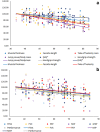Age-related declines in muscle and respiratory function are proportionate to declines in performance in Master Track Cyclists
- PMID: 34515866
- PMCID: PMC8571236
- DOI: 10.1007/s00421-021-04803-4
Age-related declines in muscle and respiratory function are proportionate to declines in performance in Master Track Cyclists
Abstract
Purpose: Respiratory and musculoskeletal function decline with age, irrespective of physical activity levels. Previous work has suggested that the age-related rate of decline in function of these two systems might be similar, but it is not known to what extent each system contributes to decreasing performance in ageing master cyclists. Therefore, the purposes of this study are (1) whether the age-related rate of decline in respiratory function, respiratory muscle strength, muscle architecture, muscle function, haemoglobin concentration, haematocrit and performance in master cyclists is uniform and (2) which parameters contribute most to the reduction in performance with age.
Methods: Master cyclists were recruited during the Track Cycling Masters World Championship 2019 in Manchester. Respiratory function and respiratory muscle strength were determined using spirometry and a mouth pressure device, respectively. Muscle architecture was determined using ultrasonography, and muscle function by countermovement jump.
Results: Forced expiratory volume in the first second, forced vital capacity, fascicle length, muscle thickness, take-off velocity, jump power, jump power per body mass, handgrip strength, haemoglobin concentration and performance correlated negatively with age (p ≤ 0.043). The age-related rate of decline did not differ significantly between parameters (p = 0.124), but it was slower for haemoglobin concentration (p = 0.041). Take-off velocity was the major determinant of performance in 200, 500 and 2000 m track cycling disciplines (R2adj = 0.675, 0.786 and 0.769, respectively; p < 0.001).
Conclusion: Age-related decline in respiratory and muscle system is accompanied by a similar rate of decline in performance. The major contribution to the age-related decline of performance is reduced muscle function, specifically take-off velocity.
Keywords: Ageing; Lung function; Master athletes; Maximum respiratory pressure; Muscle architecture; Muscle function; Respiratory function; Track cycling.
© 2021. The Author(s).
Conflict of interest statement
We declare that any of the authors listed in the authors list do not have a conflict of interest to declare.
Figures


References
-
- Barnouin Y, McPhee JS, Butler-Browne G, Bosutti A, De Vito G, Jones DA, Narici M, Behin A, Hogrel JY, Degens H. Coupling between skeletal muscle fiber size and capillarization is maintained during healthy aging. J Cachexia Sarcopenia Muscle. 2017;8(4):647–659. doi: 10.1002/jcsm.12194. - DOI - PMC - PubMed
-
- Berthelot G, Len S, Hellard P, Tafflet M, Guillaume M, Vollmer J-C, Gager B, Quinquis L, Marc A, Toussaint J-F. Exponential growth combined with exponential decline explains lifetime performance evolution in individual and human species. Age (Dordr) 2011;34(4):1001–1009. doi: 10.1007/s11357-011-9274-9. - DOI - PMC - PubMed
-
- Bhatt M, Wankhede T, Thapa B, Malhotra VK, Hira D, Kushwaha AS. Relationship between short-distance run and variables of pulmonary function tests. Natl J Physiol Pharm Pharmacol. 2015;5(2):149–152. doi: 10.5455/njppp.2015.5.051220141. - DOI
MeSH terms
LinkOut - more resources
Full Text Sources
Medical

